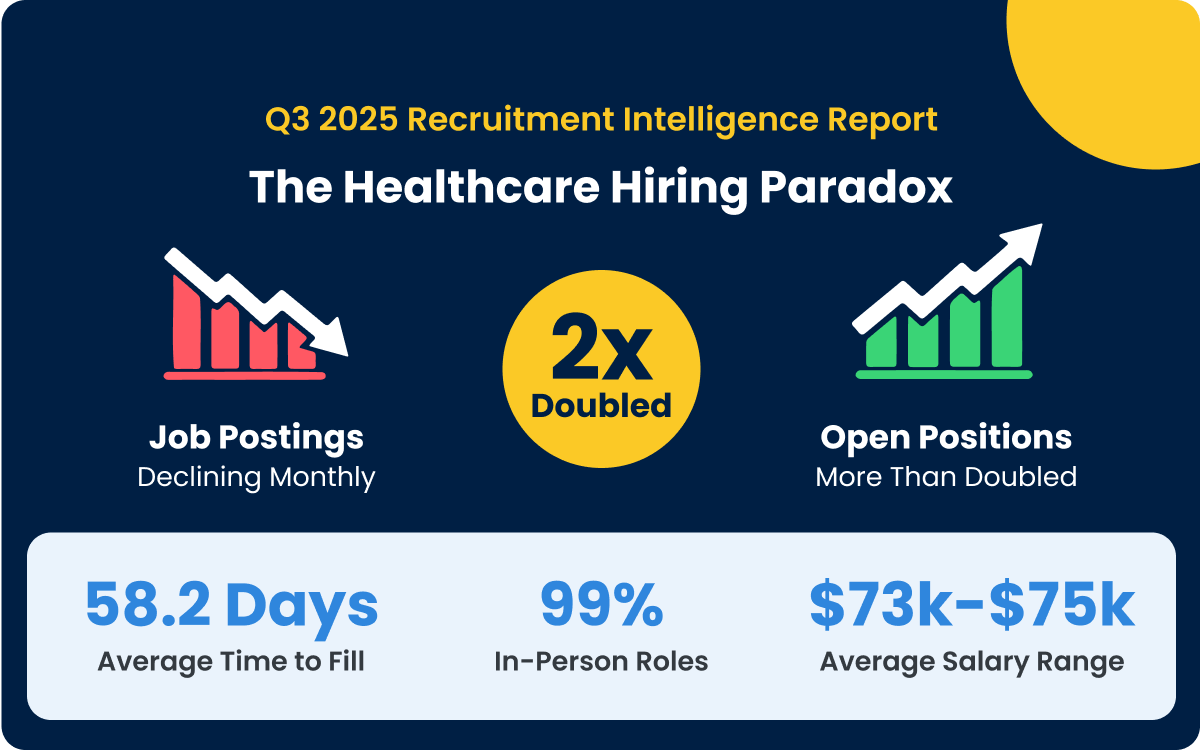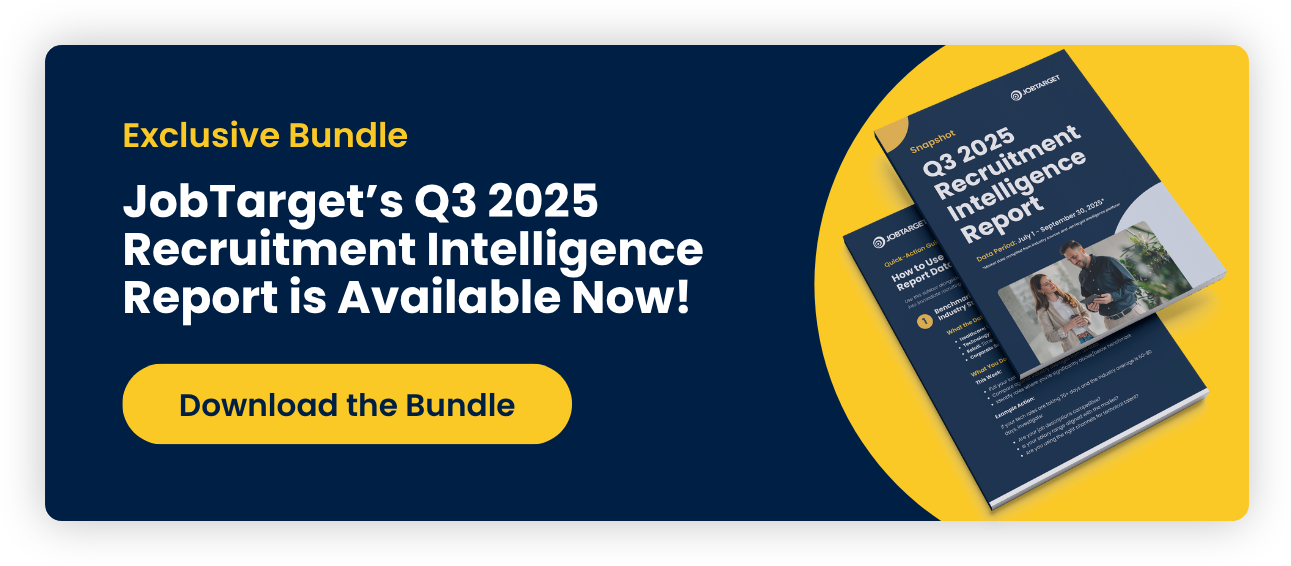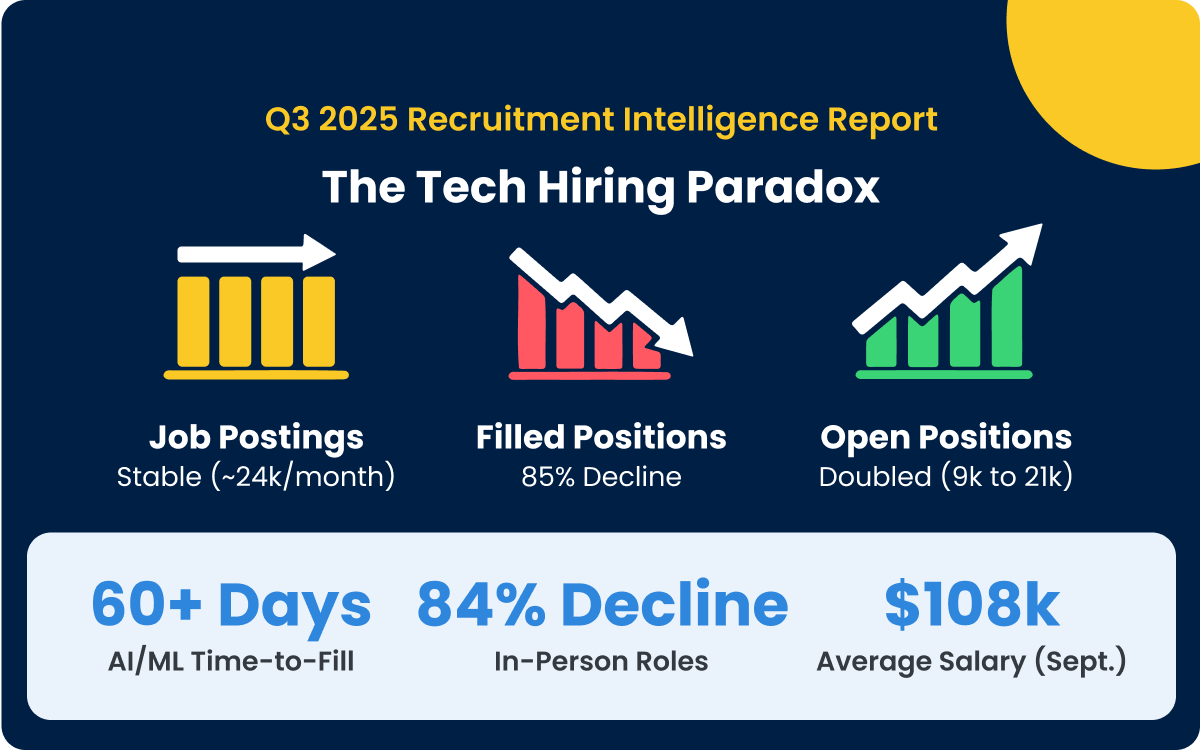Executive Summary
Healthcare recruitment faced unprecedented challenges in Q3 2025 as job postings declined monthly while open positions more than doubled. Clinical role shortages intensified across specialties, average time-to-fill stretched from 50.7 to 58.2 days, and filled positions fell sharply—creating a growing vacancy backlog that threatens care delivery and operational capacity.
Key Q3 Healthcare Findings:
- Job postings declined each month (Jul → Aug → Sep)
- Open positions more than doubled from July to September
- Filled positions dropped sharply, widening the vacancy gap
- Average salaries held steady at $73K–$75K despite rising demand
- Average time-to-fill increased from 50.7 → 58.2 days
- 99% of roles remained in-person (minimal flexibility vs. other sectors)
Market Activity Breakdown
Posting Volume vs. Fill Rates
Healthcare's Q3 paradox: declining job postings alongside exploding vacancy rates. While organizations posted fewer total jobs month-over-month, the number of unfilled positions more than doubled—indicating either posting fatigue, budget constraints, or strategic shift toward fewer, higher-quality postings.
What This Means:
Hospitals and healthcare systems aren't hiring less; they're struggling to fill what they've already posted. The backlog suggests candidate scarcity, not reduced demand.
Role-Specific Challenges
Clinical Specialties Hit Hardest:
- Specialized nursing roles (ICU, OR, ER)
- Allied health positions (respiratory therapists, radiology techs)
- Behavioral health professionals
- Certified medical assistants
Timeline Reality:
Clinical roles requiring certifications, state licenses, or specialized training consistently exceeded 60-day fill times. Credentialing and compliance requirements added 10-15 days beyond initial offer acceptance.
Compensation & Benefits Landscape
Salary Stability Amid Chaos
Average healthcare salaries remained remarkably stable at $73K–$75K throughout Q3, despite intensifying competition for talent. This suggests:
- Market maturity: Healthcare compensation somewhat standardized across regions
- Budget constraints: Healthcare systems unable or unwilling to engage in bidding wars
- Non-monetary competition: Organizations differentiating through benefits, schedules, culture
What Candidates Actually Want
With salary relatively fixed, competitive advantages shifted to:
- Scheduling flexibility: Self-scheduling, shift swapping, predictable rotations
- Professional development: Tuition reimbursement, certification support, specialty training
- Staffing ratios: Patient-to-nurse ratios, adequate support staff
- Sign-on bonuses: One-time incentives vs. permanent salary increases
- Loan forgiveness: Student loan assistance programs
Intelligence Edge:
Organizations with access to competitor benefits data and real-time market intelligence can position offers strategically beyond base salary.
Geographic & Facility Type Variations
Urban vs. Rural Divide
Urban Markets:
- Higher competition, faster offer cycles
- Salary premiums 15-20% above rural areas
- Shorter commutes valued over marginal pay increases
Rural Markets:
- Extended search timelines (70+ days average)
- Relocation incentives critical to candidate attraction
- Limited local candidate pools requiring broader geographic reach
Facility Type Considerations
Healthcare recruitment success varies significantly by facility type and organizational characteristics.
Q3 Fill Time by Facility Type:
- Large hospital systems: 52-58 days average
- Community hospitals: 60-72 days average
- Outpatient/specialty clinics: 45-55 days average
- Long-term care facilities: 65-80 days average
Why the differences:
Brand recognition, career advancement opportunities, and benefits packages gave large systems competitive edge. Smaller facilities succeeded through emphasizing culture, work-life balance, and community connection.
Recruitment Strategy Insights
What Worked in Q3
- Healthcare-Specific Distribution
Organizations focusing recruitment efforts on healthcare-specific channels and professional networks saw improved candidate quality and engagement compared to generalist approaches. - Employee Referral Programs
Clinical staff referrals consistently provided higher-quality candidates with better cultural fit. Programs with incentives for both referrer and new hire drove stronger participation. - Proactive Pipeline Building
Healthcare systems maintaining ongoing relationships with nursing schools, certification programs, and professional associations were better positioned when urgent needs arose. - Transparent Credentialing Timelines
Clear communication about licensing verification, background checks, and onboarding timelines reduced candidate anxiety and improved overall candidate experience.
What Didn't Work
- Generic Healthcare Messaging
"Join our team" and "make a difference" language failed to differentiate. Specific unit culture, advancement paths, and patient population details resonated better. - Extended Interview Processes
Multi-round interviews spanning several weeks lost candidates to faster-moving competitors. Clinical talent often evaluates multiple offers simultaneously. - Compensation Transparency Issues
Job postings without clear salary ranges received fewer applications than transparent postings, particularly as candidates increasingly expect upfront compensation information.
Competitive Intelligence Applications
Questions Healthcare Recruiters Need Answered
General Market Data Tells You:
- "Healthcare time-to-fill averages 58 days"
- "Nursing roles face shortages"
- "Salary ranges $73K–$75K"
Recruitment Intelligence Tells You:
- Specific time-to-fill for nursing roles in your exact market
- Actual salary ranges your competitors are offering for identical positions
- Which healthcare organizations are actively hiring similar roles
- Real-time competitive positioning data for your specific specialties
- Application completion rates and candidate engagement metrics
The Difference:
Stop competing without visibility into your competitive landscape. Access to specific market intelligence enables informed decisions about positioning, compensation, and resource allocation.
Recruitment Strategy Insights
What Worked in Q3
- Proactive Pipeline Building
Healthcare systems maintaining ongoing relationships with nursing schools, certification programs, and professional associations filled positions faster when needs arose. - Employee Referral Programs
Clinical staff referrals filled positions faster than external sources and showed better retention. Sign-on bonuses for both referrer and new hire drove participation. - Transparent Credentialing Timelines
Clear communication about licensing verification, background checks, and onboarding reduced candidate anxiety and improved offer acceptance rates. - Competitive Compensation Positioning
Organizations with access to market salary data could position offers competitively within the $73K-$75K average range observed in Q3.
What Didn't Work
- Generic Healthcare Messaging
"Join our team" and "make a difference" language failed to differentiate. Specific unit culture, advancement paths, and patient population details resonated better. - Slow Interview Processes
Multi-round interviews exceeding 3-4 weeks lost candidates to faster-moving competitors. Clinical talent evaluates multiple offers simultaneously. - Unclear Compensation Ranges
Job postings without salary ranges received fewer applications than transparent postings.
Questions Healthcare Recruiters Need Answered
General Market Data Tells You:
- "Healthcare time-to-fill averages 58 days"
- "Nursing roles face shortages"
- "Salary ranges $73K–$75K"
Recruitment Intelligence Tells You:
- "Registered nurses in Phoenix average 52 days to fill"
- "Competitor hospitals Banner Health, Mayo Clinic, and HonorHealth are posting ICU RN positions at $76K-$82K"
- "Your local competitors posted 15+ ICU positions in Q3"
- "68% of competitor postings include sign-on bonuses averaging $5K-$8K"
The Difference:
Stop competing blind. Know exactly what competitors offer and position accordingly.
Q4 Healthcare Outlook
Expected Trends
- Sustained Clinical Shortages
Q4 will see continued pressure on clinical roles as flu season, holiday staffing, and budget year-end hiring converge. - Increased Compensation Transparency
More healthcare organizations will include salary ranges as states enact pay transparency laws and candidates demand clarity. - Retention Focus
The high cost of replacing clinical staff will drive increased retention initiatives alongside recruitment efforts. - Technology Adoption
AI-powered screening, automated credentialing tracking, and candidate relationship management tools will differentiate high-performing organizations.
Strategic Recommendations for Q4
Immediate Actions:
- Audit recruitment channel performance: Identify which healthcare-specific platforms deliver qualified candidates
- Benchmark compensation: Compare current offers against competitive market data
- Streamline credentialing: Reduce time between offer acceptance and start date through process optimization
- Build specialty pipelines: Identify critical roles and begin proactive outreach to passive candidates
- Enhance referral programs: Increase incentives and promote actively to clinical staff
Strategic Initiatives:
- Partner with educational programs: Establish relationships with nursing schools, allied health programs, certification courses
- Develop retention metrics: Track retention by hire source to optimize quality of hire
- Create transparent career paths: Show clinical advancement opportunities, specialty training, leadership development
- Optimize mobile experience: Ensure application processes work seamlessly on mobile devices
The Intelligence Advantage for Healthcare
Healthcare recruitment requires specialized insight that general market data can't provide. While industry benchmarks show broad trends, recruitment intelligence reveals market-specific opportunities.
Organizations using healthcare-specific recruitment intelligence have access to:
- Customized data for their facility type and specialties
- Competitor salary and benefits benchmarking
- Market-specific time-to-fill trends
- Job posting and repost frequency analysis
Take Action
Use This Data To:
- Reset leadership expectations with Q3 benchmarks (58-day fills realistic for clinical roles)
- Justify recruitment budget increases with industry trends
- Optimize Q4 spending based on healthcare-specific performance data
- Develop proactive pipeline strategies for critical specialties
Want Healthcare Intelligence Specific to Your Market?
Stop guessing which strategies work. Get customized data for your facility type, specialties, and competitive landscape.
Schedule Demo | Download Full Q3 Report
Healthcare-specific insights from Q3 2025 Recruitment Intelligence data




.png)


